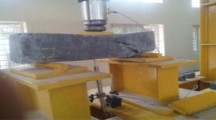Abstract
This article outlines laboratory and full-scale studies on fire resistance of SCC. For this purpose 40 pre-stressed columns and 140 cylinders of concrete were subjected to compressive loading at high temperature. The SCC included water-binder ratios, w/b, between 0.40 and 0.70 and large amount limestone powder. Comparison was done with vibrated concrete, VC, with the same w/b. Mix proportions were chosen as regards tunnel concrete (w/b=0.40), prefabricated concrete (w/b=0.55) and concrete for production of dwelling houses (w/b=0.70). The waterpowder ratio, w/p varied between 0.28 and 0.70. The fullscale behaviour showed extensive fire spalling for water-cured concrete at w/p<0.40 and for air-cured concrete at w/p<0.35. One way of avoiding the fire spalling was to introduce polypropylene fibres, PPF, in the mix proportions, which was chosen to be very effective. The laboratory results on small cylinders indicated similar material behaviour of SCC and VC at high temperature when spalling did not occur. The project was performed 1999–2002.
Résumé
Cet article traite des études en laboratoire et des essais en grandeur nature sur la résistance au feu du béton autocompactant. Pour cette étude, plus de 40 poutres précontraintes et 140 cylindees ont été soumis à des charges compressives à haute température. Le béton présentait un rapport eau/liant se situant entre 0.40 et 0,70 et contenait une forte proportion de poudre de pierre à chaux. Des comparaisons ont été effectuées avec des bétons vibrés ayant le même rapport eau/liant. Les compositions ont été choisies en fonction du béton destiné à la construction de tunnels (0,40), de celui pour la construction préfabriquée (0,55) et du béton destiné à la production d'immeubles (0,70). Le rapport eau/poudre variait entre 0,28 et 0,70. Lors des essais en grandeur nature, le comportement démontrait un important écaillage au feu pour le béton conservé sous eau ayant un rapport eau/poudre<0,40 et pour le béton conservé à l'air d'un rapport eau/poudre<0.35. Un moyen d'évier cet écaillage a été d'incorporer dans les compositions, des fibres de polypropylène choisies pour leur haute performance. Les résultats en laboratoire sur des cylindres de petites dimensions ont indiqué un comportement similaire du matériau pour le béton auto-compactant et le béton vibré à haute température et il ne s'est pas produit d'écaillage. Ce projet a été réalisé entre 1999 et 2002.
Similar content being viewed by others
References
Persson, B., ‘Assessment of Chloride Migration, Salt, Internal Frost and Sulphate Resistance of SCC’, TVBM 3100, Lund Institute of Technology, Lund, 2001, 86 p.
Persson, B., ‘Internal Frost Resistance and Salt Frost Scaling of Self-Compacting Concrete’,Cement and Concrete Research 33 (2003) 373–379.
Persson, B., ‘Sulphate resistance of SCC’,Cement and Concrete Research (Accepted for publication, 2003).
Anderberg, Y. and Oredsson, J. and Rise, G., ‘HPC Constructions-Hand Book’, (Swedish Byggtjänst, Stockholm, 2000) 49–58.
Phan, L., ‘High-Strength Concrete at High Temperature—An Overview’, Symposium on Utilization of High Strength/High Performance Concrete, Ed.: de Larrard, F. and Lacroix, R. (Presses de l'École Nationale des Ponts et Chaussées, Paris, 1996) 501–518.
Lennon, T., Bailey, C. and Clayton, N., The Performance of High Grade Concrete Columns in Fire, Utilization of High Strength/HPC. University of Leipzig. Ed.: König, G., Dehn, F. and Faust, T. (Verein der Freunde des Bauingenieur- und Wirtschaftsingerieurwesens an der Universität Leipzig, Leipzig. 2002) 341–353.
Diedrichs, U., Jumppanen, U.-M. and Schneider, U., ‘High Temperature Properties and Spalling Behaviour of High Strength Concrete’, Weimar, Ed. Wittmann, F.H. and Schwesinger, P. (AEDIFICATIO Publishers, Freiburg and Unterengstringen, 1995) 129–143.
Persson, B., ‘Self-compacting concrete at fire temperatures’, TVBM-3110, Lund Institute of Technology, Lund, 2003, 200 p.
Boström, L., ‘SCC with PPF resists fire’,SP Brandposten 26 (2002) 15.
Boström, L., ‘SCC exposed to fire’,Bygg & Teknik 07 (2002) 35–36.
Thelandersson, S., ‘Mechanical Behaviour of Concrete under Torsional Loading at Transient, High-Temperature Conditions’, Bulletin 46, Div. Structural Mechanics and Concrete Construction, 1974, 25–35.
Neville, A.M. and Brooks, J.J., ‘Concrete Technology’ (Longman, Singapore, 1987) 70.
Persson, B. ‘Hydration, Structure and Strength of High-Performance Concrete’, TVBM-1009, Lund Institute of Technology, Lund, 1992, 400 p.
Boström, L., ‘The Performance of some SCC when exposed to fire’, 2002;23, Fire Technology. SP, Swedish National Testing and Research Institute, 37p.
Noumowé, N.A., Clastres, P. and Debicki, G. and Costaz, J.-L., ‘Thermal stresses and water vapour pressure of HPC at high temperature’, Symposium on Utilization of High Strength/High Performance Concrete, Ed.: de Larrard, F., Lacroix, R., (Presses de l'École Nationale des Ponts et Chaussées, Paris, 1996) 561–570.
Author information
Authors and Affiliations
Additional information
Editorial note Dr. Bertil Persson is a RILEM Senior Member. He participates in RILEM TCs LTP ‘Life time performance of materials and structures’. URM'Use of Recycled Materials’, 196-ICC ‘Internal curing of concretes’ and 195-DTD ‘Recommendation for test methods for autogenous deformation and thermal dilation of early age concrete’.
Rights and permissions
About this article
Cite this article
Persson, B. Fire resistance of self-compacting concrete, SCC. Mat. Struct. 37, 575–584 (2004). https://doi.org/10.1007/BF02483286
Received:
Accepted:
Issue Date:
DOI: https://doi.org/10.1007/BF02483286




